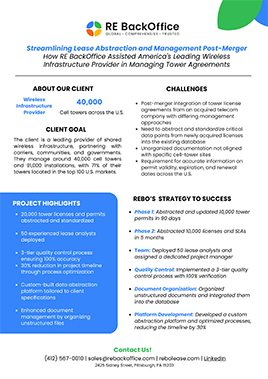
In the vast landscape of commercial real estate, the success of lease abstraction, lease administration, and CAM reconciliation processes hinges on a thorough understanding of critical lease data. These vital pieces of information serve as the bedrock upon which lease agreements are built and managed. Let's embark on a comprehensive exploration of the fundamental components of critical lease data and unravel their importance in commercial real estate management.
Property Name:
At the forefront of any lease agreement lies the property name, which acts as the primary identifier for the leased space. This includes office buildings, shopping malls, industrial complexes, and more. The property name not only provides clarity regarding the location of the premises but also sets the foundation for effective lease management.
Landlord's Address:
Clear communication channels between landlords and tenants are essential for the smooth operation of lease agreements. The landlord's address serves as a pivotal point of contact for correspondence, ensuring that important notices, inquiries, and requests are promptly addressed. Understanding the landlord's address facilitates efficient communication and fosters a positive landlord-tenant relationship.
Payee Address:
Rent payments are a fundamental aspect of lease agreements, and knowing where to send these payments is crucial for both landlords and tenants. The payee address designates the destination to which rent payments should be directed, whether it be the landlord's address or a designated entity responsible for rent collection. Clarity on the payee address streamlines financial transactions and minimizes the risk of payment errors or delays.
Tenant Address:
Just as the landlord's address is important for communication purposes, the tenant's address plays a critical role in lease administration. This address serves as the primary contact point for the tenant, ensuring that they receive important notices, updates, and communications related to the lease agreement. Understanding the tenant's address facilitates effective communication and helps maintain a strong landlord-tenant relationship.
Tenant Trade Name:
The trade name of the tenant reflects their brand identity and commercial presence within the leased premises. This name not only distinguishes the tenant from other businesses but also provides valuable insights into their operational scope and industry niche. Understanding the tenant's trade name is essential for lease abstraction and lease administration, as it helps identify the tenant's business activities and compliance with lease terms.
Premises Address:
Precise knowledge of the premises address is paramount for lease administration and property management. This address delineates the exact location of the leased space, providing clarity for both landlords and tenants. It ensures that all parties involved have a clear understanding of the physical boundaries and specifications of the leased premises, thereby minimizing potential disputes or misunderstandings.
Premises Square Footage:
The square footage of the leased premises is a fundamental metric that influences various aspects of lease agreements, including rent calculations, space utilization, and tenant obligations. Understanding the premises square footage allows landlords and tenants to accurately assess the size and scope of the leased space, facilitating fair and transparent lease negotiations. It ensures that rent payments are commensurate with the actual size of the premises and enables tenants to effectively plan for their spatial needs.
Commencement Date:
The commencement date marks the official start of the lease term and is a critical milestone in lease agreements. This date signifies when the rights and obligations outlined in the lease agreement come into effect, including rent payments, occupancy rights, and lease terms. Understanding the commencement date is essential for both landlords and tenants, as it sets the timeline for lease administration and financial planning.
Rent Commencement Date:
Distinct from the commencement date, the rent commencement date marks the beginning of rent payments by the tenant. This date may coincide with the commencement date or differ based on the terms of the lease agreement. Understanding the rent commencement date is crucial for accurate financial planning and budgeting, as it determines when tenants are obligated to start paying rent and landlords can expect to receive rental income.
Lease Status:
The status of the lease agreement - whether it is active, expired, or operating on a month-to-month basis - provides valuable insights into its current state and future trajectory. An active lease indicates that the terms of the agreement are still in effect, while an expired lease has reached its conclusion. Understanding the lease status enables landlords and tenants to make informed decisions regarding lease renewals, terminations, and amendments.
Permitted Use:
Permitted use clauses define the allowable activities and purposes for which the leased premises can be utilized by the tenant. These clauses safeguard the landlord's property interests and ensure that tenants comply with the terms of the lease agreement. Understanding the permitted use of the premises helps landlords enforce lease restrictions and maintain the integrity of the leased property.
Rent:
Rent is a core component of lease agreements and represents the financial consideration paid by tenants in exchange for the right to occupy the leased premises. This includes base rent as well as additional expenses such as operating costs, taxes, insurance, and utilities. Understanding the terms and conditions of rent payments is essential for both landlords and tenants, as it forms the basis of their financial obligations and commitments under the lease agreement.
Security Deposit:
Security deposits provide landlords with a financial safeguard against potential lease defaults, property damages, and unpaid rent. These deposits are typically collected from tenants at the beginning of the lease term and held in escrow until the end of the tenancy. Understanding the purpose and terms of the security deposit helps landlords mitigate risks and protect their investment in the leased property.
Prepaid Rent:
Prepaid rent refers to rent payments made in advance by tenants before the commencement of the lease term. These payments provide landlords with immediate cash flow and financial security, while also giving tenants flexibility in lease commencement dates. Understanding prepaid rent enables landlords and tenants to negotiate lease terms and payment schedules that meet their respective needs and preferences.
Tenant's Proportionate Share:
The tenant's proportionate share represents their allocated portion of shared expenses such as common area maintenance (CAM) costs, property taxes, and insurance premiums. This share is typically calculated based on the tenant's square footage relative to the total leasable area of the property. Understanding the tenant's proportionate share helps landlords allocate expenses fairly among tenants and maintain transparency in lease agreements.
Calculation of Tenant's Proportionate Share
The tenant's proportionate share is typically determined based on the tenant's square footage relative to the total leasable area of the property. The formula used is straightforward:
Tenant's Proportionate Share = (Area occupied by tenant / Area of the property) x 100%
For example, if a tenant leases 1,000 square feet in a shopping center that has a total leasable area of 10,000 square feet, the tenant's proportionate share would be:
(1,000 / 10,000 )x100%=10%
This means the tenant is responsible for 10% of the shared expenses.
Lease Year:
Lease years are pivotal components of lease agreements, defining the span of tenant occupancy and associated financial obligations. They can align with either calendar or fiscal years, serving as vital tools for tracking lease milestones and facilitating financial planning. Landlords utilize lease years for cash flow projections and property management, while tenants rely on them for budgeting and strategic decision-making. Understanding lease years ensures adherence to contractual terms, promotes transparency, and fosters equitable treatment for all parties involved in leasing arrangements.
Calendar Year and Base Year:
Calendar years and base years are fundamental components of lease agreements and financial assessments, providing temporal reference points for both landlords and tenants.
Calendar years, spanning from January to December, offer a standardized framework for measuring time within lease contracts. They facilitate clear understanding and synchronization of lease terms, including commencement and expiration dates, rental payments, and renewal options.
In contrast, base years serve as the starting point for calculating various financial obligations outlined in the lease agreement. These may include operating expenses, taxes, and other expenses incurred by the landlord that are passed on to the tenant. Base years provide a benchmark against which fluctuations in expenses can be measured, typically serving as the reference point for expense escalations or reimbursements.
Understanding both calendar years and base years is essential for landlords and tenants alike. It enables them to navigate lease terms accurately and anticipate financial obligations with clarity. By comprehending these temporal and financial aspects, parties can ensure fair and transparent dealings throughout the duration of the lease agreement.
Size of the Premises:
The size of the leased premises influences rent calculations, space utilization, and tenant obligations. Understanding the square footage and layout of the premises allows landlords and tenants to maximize the value and utility of the leased space. It also helps ensure that rent payments are appropriate for the actual size of the premises and enables tenants to plan their space usage effectively.
By understanding and paying attention to these critical lease data points, stakeholders can navigate the complexities of commercial real estate management with confidence and clarity. From property names to lease statuses, each detail plays a vital role in ensuring smooth lease abstraction, lease administration, and CAM reconciliation processes. This comprehensive understanding of critical lease data empowers landlords and tenants to make informed decisions, maintain transparent communication, and foster a positive and productive landlord-tenant relationship.


